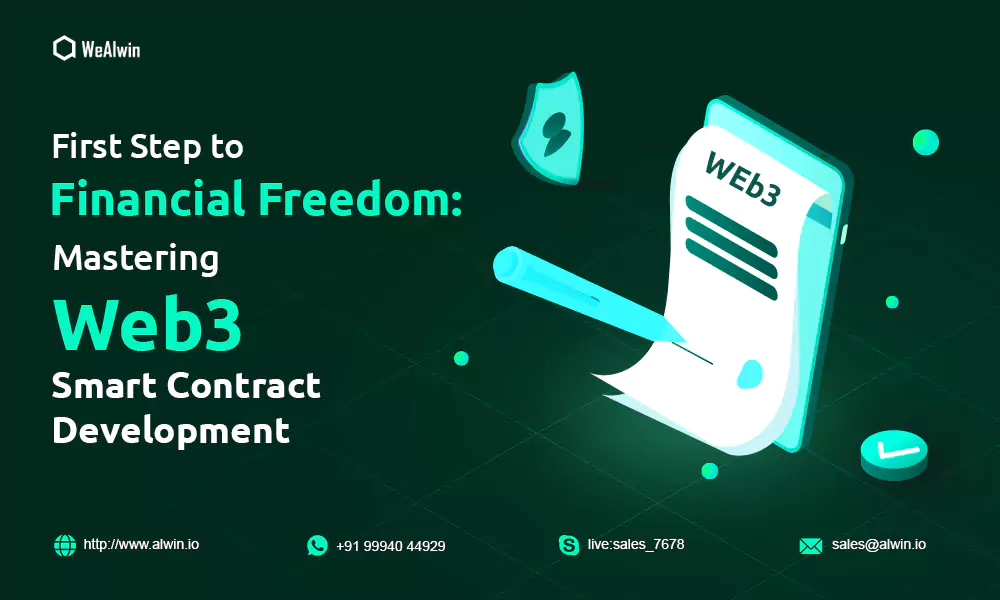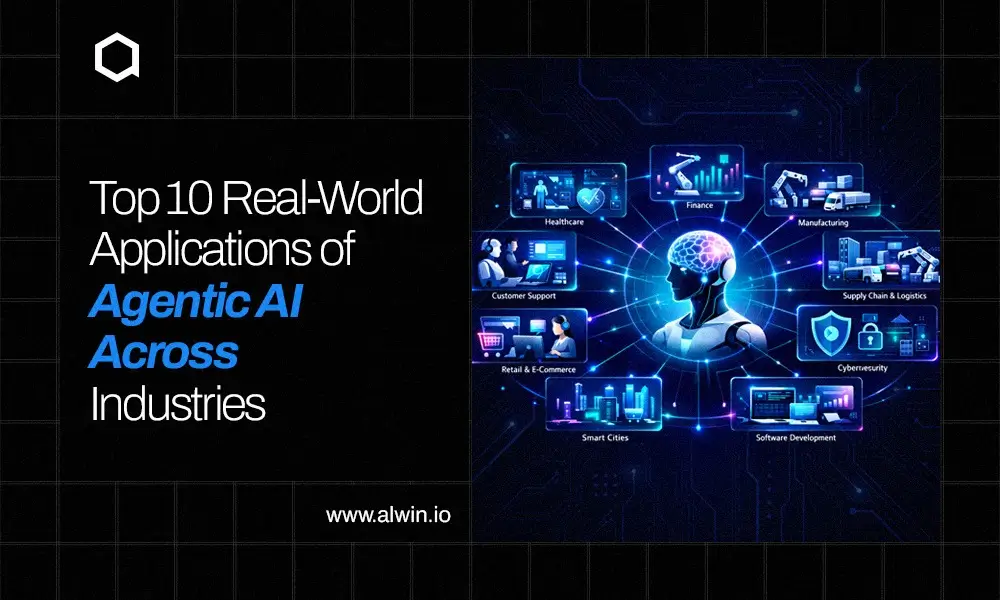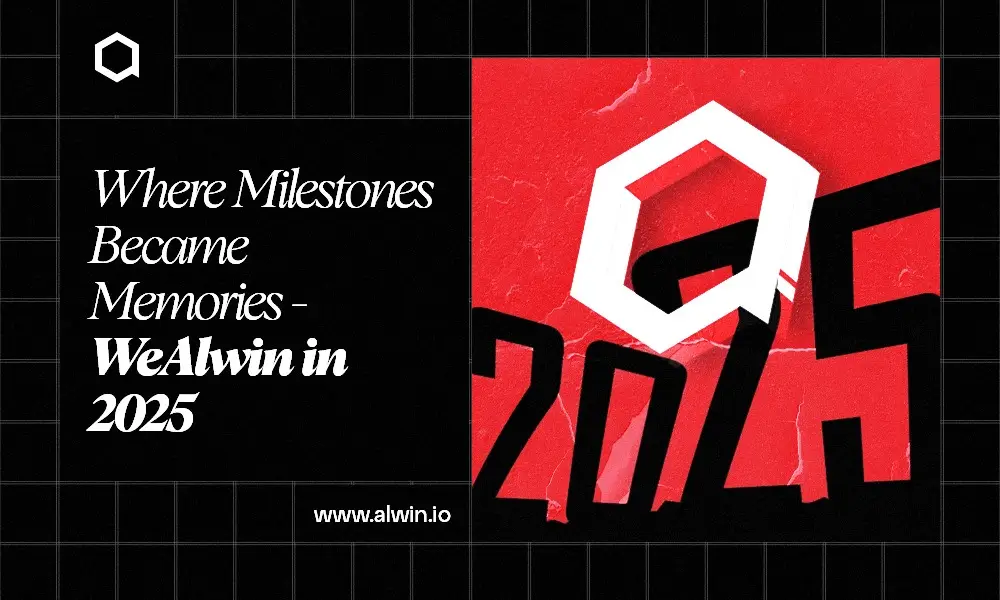In today's rapidly evolving digital landscape, traditional financial systems are undergoing a remarkable transformation. The emergence of Web3 technology has paved the way for a new era of decentralized financial solutions, offering individuals unparalleled opportunities for financial freedom.
If you're eager to explore the world of smart contract development and embark on a journey toward financial independence, this blog post is your first step.
Come let's get started on the journey of financial freedom with the help of blockchain.
What is Web3?
Web3 represents the next generation of internet technology that leverages blockchain and decentralized principles to reshape how we interact and transact online. Unlike its predecessor, Web2, which relied on central authorities, Web3 empowers individuals by giving them control over their data and digital assets.

Web3 comprises several essential components that form the backbone of this revolutionary technology. At its core, blockchain technology provides the foundation for secure and transparent transactions.
Decentralized Applications (DApps) enable the creation of user-centric platforms, while smart contracts act as the building blocks for automated and self-executing agreements.
The Power of Smart Contracts
Smart contracts are self-executing agreements written as code and deployed on a blockchain. They facilitate trust and remove intermediaries by automatically executing predefined actions when certain conditions are met. Smart contracts are the heart and soul of Web3 technology, unlocking a world of possibilities. The working principle of smart contracts is very simple.
Smart contracts offer numerous benefits that contribute to the promise of financial freedom. With smart contracts, individuals can engage in automated payments and remittances, tokenize assets, participate in decentralized finance (DeFi), and streamline supply chain management.

Use Cases of Smart Contracts
The versatility of smart contracts is evident in their wide range of applications.
Let's explore some common use cases:
Automated Payments and Settlements
Smart contracts enable automatic payment execution based on predetermined conditions. Whether it's salary payments, subscription renewals, or cross-border remittances, smart contracts ensure efficiency and accuracy while eliminating the need for intermediaries.
Tokenization of Assets
Using smart contracts, real-world assets such as real estate, art, or intellectual property can be tokenized and represented on the blockchain. This allows for fractional ownership, increased liquidity, and a broader range of investment opportunities.
Decentralized Finance (DeFi)
Smart contracts are the backbone of the booming DeFi ecosystem. They enable various financial services, including lending, borrowing, trading, and yield farming, without the need for traditional financial intermediaries. DeFi protocols built on smart contracts offer individuals greater control over their funds and financial activities.
Supply Chain Management
By automating procedures like inventory management, order fulfilment, and payment settlements, smart contracts streamline supply chain operations. This ensures transparency, reduces inefficiencies, and minimizes the risk of fraud or counterfeit products.
Getting Started with Web3 Smart Contract Development
To embark on your journey toward mastering Web3 smart contract development, you'll need to follow a few essential steps:

Choosing a Blockchain Platform
Different blockchain platforms cater to various use cases. Ethereum is the most popular choice for smart contract development, offering a robust ecosystem and widespread adoption. Other platforms like Polkadot, Binance Smart Chain, and Solana also provide unique features and opportunities.
To know about the detailed comparison of various blockchain platforms such as Polkadot, Ethereum, cardio, etc.
Setting Up a Development Environment
Setting up a development environment involves installing the necessary tools and frameworks for smart contract development. You'll need an Integrated Development Environment (IDE), a blockchain client, and testing tools to ensure smooth development and deployment.

Programming Languages for Smart Contracts
Several programming languages are used for smart contract development. The most widely used language is Solidity, specifically designed for Ethereum. Vyper, a language focused on security, and Rust, known for its performance, are also gaining popularity.

Building Smart Contracts
A smart contract consists of code that defines the logic and behavior of the agreement. It typically includes functions, variables, and event triggers that define how the contract interacts with other components of the blockchain.
Solidity is a high-level, statically-typed language used for writing smart contracts on the Ethereum platform. It provides intuitive syntax and extensive libraries, making it a popular choice for developers.
Solidity supports various features like inheritance, modifiers, and interfaces, enabling complex contract designs.
After writing a smart contract, it needs to be deployed to the blockchain. Deployment involves interacting with the blockchain network and broadcasting the contract's bytecode and constructor parameters. Once deployed, the contract can be interacted with through transactions and calls.
Thorough testing and debugging are crucial to ensure the reliability and security of smart contracts.
Various testing frameworks and tools, such as Truffle and Hardhat, provide comprehensive testing environments to validate contract functionality and catch potential issues.
Security Considerations for Smart Contracts
Developing secure smart contracts is foremost to protecting users' funds and data.
Here are some key security considerations:
Common Smart Contract Vulnerabilities
Understanding common smart contract vulnerabilities like re-entrance attacks, integer overflow/underflow, and unauthorized access is crucial to prevent potential exploits. By familiarizing yourself with these vulnerabilities, you can implement appropriate security measures.
Best Practices for Secure Development
Following best practices such as code reviews, input validation, and access control mechanisms helps mitigate security risks. Writing clean and modular code, employing secure libraries, and staying updated on the latest security practices are essential habits for secure smart contract development.
Auditing and Code Review
Engaging independent security auditors to review your smart contract code can provide valuable insights and help identify potential vulnerabilities. The development process must include auditing to provide the greatest level of security.
Web3 Tools and Frameworks
Several tools and frameworks simplify the development process and enhance efficiency when working with Web3 technology:
Overview of Web3 Development Tools
Truffle Suite: Truffle provides a suite of tools for smart contract development, testing, and deployment. It includes a development environment, testing framework, and building a pipeline to streamline the entire development lifecycle.
Hardhat: It’s a popular development environment for Ethereum projects. It offers built-in tasks, and testing utilities, and supports TypeScript, enabling developers to write clean and type-safe smart contracts.
To create the sample project, run npx hardhat in your project folder:

Remix IDE: Remix is a powerful browser-based IDE that allows developers to write, test, and deploy smart contracts.

It provides an intuitive user interface and seamless integration with various Ethereum networks.
Web3.js: Web3.js is a JavaScript library that provides an interface to interact with smart contracts and the Ethereum blockchain. It simplifies complex tasks like contract deployment, data reading, and transaction execution.
Infura: Infura is an infrastructure provider that offers reliable and scalable access to the Ethereum and IPFS networks.

It simplifies the process of connecting applications to the blockchain without the need to run a full node.
Interacting with Smart Contracts
Web3.js: A JavaScript Library for Web3 Interaction
Web3.js is a powerful JavaScript library that bridges your web application and the Ethereum blockchain. It provides a comprehensive set of functions and APIs for interacting with smart contracts and blockchain data. To interact with a deployed smart contract, you need to connect to its address on the blockchain.
Web3.js enables you to establish this connection and access the contract's functions and data. Web3.js allows you to read data stored in smart contracts. You can retrieve information such as token balances, contract states, or transaction history by calling the appropriate contract functions.
While interacting with a smart contract often involves writing transactions to the blockchain. Web3.js simplifies this process by providing functions to sign transactions, estimate gas costs, and submit transactions to the network.
Web3 Smart Contract Deployment
Preparing for Deployment
Before deploying a smart contract to the live blockchain, it's essential to conduct thorough testing and ensure that the code is secure and bug-free. This includes simulating different scenarios, verifying contract functionality, and performing extensive code reviews.
Deploying Smart Contracts on Testnet
Testnets are Ethereum networks designed for testing and experimentation. Deploying smart contracts on testnets allows you to validate their functionality and behavior without incurring real transaction costs. Popular testnets include Ropsten, Kovan, and Rinkeby.
Deploying Smart Contracts on Mainnet
Once you're confident in the contract's functionality and security, it's time to deploy it on the Ethereum mainnet. Mainnet deployment involves real transactions and incurs gas fees. It's crucial to double-check all parameters and thoroughly test the deployment process.
Real-World Examples of Web3 Smart Contracts
Web3 smart contracts have revolutionized various industries and introduced new possibilities. Here are a few real-world examples:
Ethereum-based DeFi Protocols
Decentralized finance (DeFi) protocols like Compound, Aave, and Uniswap have transformed traditional financial services. These protocols leverage smart contracts to enable lending, borrowing, yield farming, and decentralized trading, providing individuals with financial opportunities that were previously inaccessible.
Did You Think of building your own Decentralized Finance (DeFi) See what we are doing in the DeFi Protocols.
Non-Fungible Tokens (NFTs)
Non-Fungible Tokens have gained immense popularity, allowing the representation and ownership of unique digital assets. NFTs utilize smart contracts to ensure provable scarcity, ownership rights, and transparent transactions in the world of digital art, collectibles, and virtual real estate.
Decentralized Exchanges
Decentralized exchanges such as SushiSwap, PancakeSwap, and 1inch have disrupted the traditional exchange landscape. These exchanges rely on smart contracts to enable peer-to-peer trading, removing the need for intermediaries and offering users more control over their funds.
Challenges and Future of Web3 Smart Contract Development
While Web3 smart contract development presents numerous opportunities, it also faces challenges that require innovation and continuous improvement.
Scalability and Gas Fees
The scalability of blockchain networks and the associated gas fees remain critical issues. As Web3 technology evolves, layer 2 solutions, sharding, and other scaling techniques are being explored to address these challenges.
Interoperability and Cross-Chain Solutions
Interoperability between different blockchain networks is vital for the growth of Web3 technology. Cross-chain solutions like Polkadot, Cosmos, and interoperability protocols aim to bridge different blockchains and enable seamless communication and asset transfer.
Upcoming Web3 Technologies and Innovations
The future of Web3 development is promising, with ongoing research and development. Innovations such as Web3 standards, advanced consensus algorithms, and privacy-focused solutions are on the horizon, expanding the possibilities for decentralized finance and self-sovereign applications.
Conclusion
We delved into the evolution of financial systems, the rise of Web3 technology, and the promises it holds. Understanding Web3, the power of smart contracts, tools, and frameworks involved is crucial for embarking on this transformative journey.
By building smart contracts, interacting with them, and deploying them on the blockchain, you can unlock real-world applications and contribute to the ever-growing Web3 ecosystem. While challenges exist, the future of Web3 smart contract development is bright, filled with opportunities for innovation and financial freedom.
Remember one thing in mind, the first step is just the beginning. Embrace the world of Web3, expand your knowledge, and embark on a rewarding path toward financial independence.



